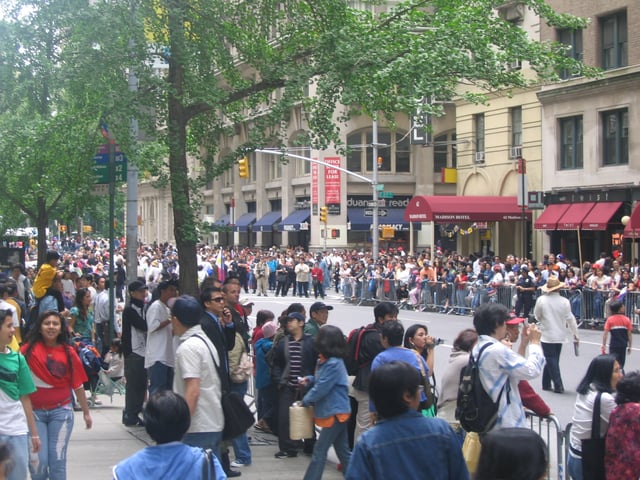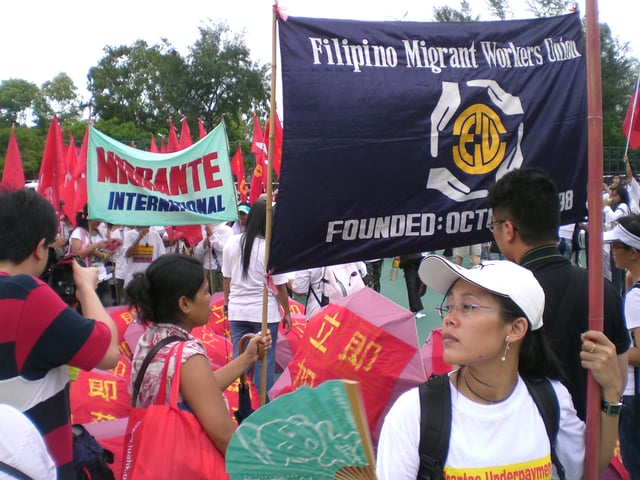Filipinos
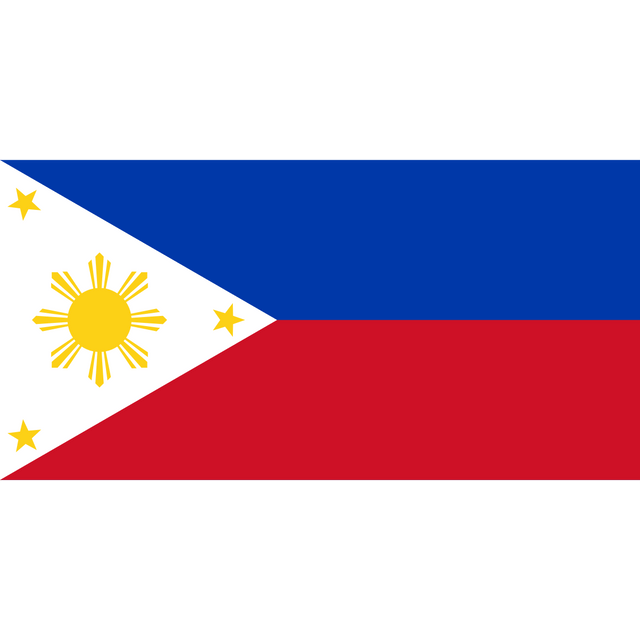
Filipinos

| Total population | |
|---|---|
| c. 100 million[1]( 10 million inFilipino diaspora) | |
| Regions with significant populations | |
| Philippinesc. 100 million | |
| 2,555,923[2] | |
| 1,020,000[3] | |
| 837,130[4] | |
| 679,819[5] | |
| 325,089[6] | |
| 260,553[7] | |
| 232,386[8] | |
| 195,558[3] | |
| 175,000[9] | |
| 167,859[10] | |
| 130,810[11] | |
| 115,362[12] | |
| 112,000[3] | |
| 108,520[13] | |
| 63,464[14] | |
| 40,347[15] | |
| 31,000[16] | |
| 25,000[17] | |
| 20,937[18] | |
| 20,589[19] | |
| 17,574[20] | |
| 14,544[21] | |
| 13,000[22] | |
| 12,791[23] | |
| 12,474[24] | |
| 12,262[25] | |
| 12,254[26] | |
| 10,000'[27] | |
| 7,000[28] | |
| 7,000[29] | |
| 6,500[30] | |
| 5,500[31] | |
| 5,000[32] | |
| 4,809[33] | |
| 4,800[34] | |
| 4,500[35] | |
| 2,114[36] | |
| 3,000[37] | |
| 2,900[38] | |
| Languages | |
| Filipinoand otherlanguages of the Philippines | |
| Religion | |
| PredominantlyRoman Catholicism[39]Minority others are: | |
| Related ethnic groups | |
| Austronesian peoples | |
Filipinos (Filipino: Mga Pilipino)[40] are the people who are native to or identified with the country of the Philippines. Filipinos come from various Austronesian ethnolinguistic groups. Currently, there are more than 175 ethnolinguistic groups, each with its own language, identity, culture and history. The modern Filipino identity, with its Austronesian roots, was mainly influenced by China, the United States and Spain.
| Total population | |
|---|---|
| c. 100 million[1]( 10 million inFilipino diaspora) | |
| Regions with significant populations | |
| Philippinesc. 100 million | |
| 2,555,923[2] | |
| 1,020,000[3] | |
| 837,130[4] | |
| 679,819[5] | |
| 325,089[6] | |
| 260,553[7] | |
| 232,386[8] | |
| 195,558[3] | |
| 175,000[9] | |
| 167,859[10] | |
| 130,810[11] | |
| 115,362[12] | |
| 112,000[3] | |
| 108,520[13] | |
| 63,464[14] | |
| 40,347[15] | |
| 31,000[16] | |
| 25,000[17] | |
| 20,937[18] | |
| 20,589[19] | |
| 17,574[20] | |
| 14,544[21] | |
| 13,000[22] | |
| 12,791[23] | |
| 12,474[24] | |
| 12,262[25] | |
| 12,254[26] | |
| 10,000'[27] | |
| 7,000[28] | |
| 7,000[29] | |
| 6,500[30] | |
| 5,500[31] | |
| 5,000[32] | |
| 4,809[33] | |
| 4,800[34] | |
| 4,500[35] | |
| 2,114[36] | |
| 3,000[37] | |
| 2,900[38] | |
| Languages | |
| Filipinoand otherlanguages of the Philippines | |
| Religion | |
| PredominantlyRoman Catholicism[39]Minority others are: | |
| Related ethnic groups | |
| Austronesian peoples | |
Names
The name Filipino was derived from the term las Islas Filipinas ("the Philippine Islands"),[41] the name given to the archipelago in 1543 by the Spanish explorer and Dominican priest Ruy López de Villalobos, in honour of Philip II of Spain (Spanish: Felipe II).
During the Spanish colonial period the term Filipino was used to classify Spaniards born in the Philippine islands, while the indigenous Austronesian peoples of the islands were called Indio.[42] Historian Ambeth Ocampo has suggested that the first documented use of the word to Filipino to refer to Indios was the Spanish-language poem A la juventud filipina, published in 1879 by José Rizal.[43]. Apolinario Mabini (1896) used the term Filipino to refer to all inhabitants of the Philippines. Father Jose Burgos earlier called all natives of the archipelago as Filipinos.[44]
The lack of the letter "F" in the pre-1987 Tagalog alphabet (Abakada) caused the letter "P" to be substituted for "F", though the alphabets and/or writing scripts of some non-Tagalog ethnic groups included the letter "F". Upon official adoption of the modern, 28-letter Filipino alphabet in 1987, the term Filipino was preferred over Pilipino. Locally, some still use "Pilipino" to refer to the people and "Filipino" to refer to the language, but in international use "Filipino" is the usual form for both.
A number of Filipinos refer to themselves colloquially as Pinoy" (feminine: "Pinay"), which is a slang word formed by taking the last four letters of "Filipino" and adding the diminutive suffix "-y".
Other collective endonyms for the Filipino people include: "Patria Adorada" (Spanish for "Beloved Fatherland") as popularized by Jose Rizal through his poem "Mi último adiós", "Bayang Pilipino" (Tagalog: "Filipino nation") or the more poetic "Sambayanáng Pilipino" (a formal term in Tagalog meaning "one/entire Filipino nation").
History
Prehistory
In 2010, a metatarsal from "Callao Man", discovered in 2007, was dated through uranium-series dating as being 67,000 years old.[45]
Prior to that, the earliest human remains found in the Philippines were thought to be the fossilized fragments of a skull and jawbone, discovered in the 1960s by Dr. Robert B. Fox, an anthropologist from the National Museum.[46] Anthropologists who examined these remains agreed that they belonged to modern human beings. These include the Homo sapiens, as distinguished from the mid-Pleistocene Homo erectus
The "Tabon Man" fossils are considered to have come from a third group of inhabitants, who worked the cave between 22,000 and 20,000 BCE. An earlier cave level lies so far below the level containing cooking fire assemblages that it must represent Upper Pleistocene dates like 45 or 50 thousand years ago.[47] Researchers say this indicates that the human remains were pre-Mongoloid, from about 40,000 years ago. Mongoloid is the term which anthropologists applied to the ethnic group which migrated to Southeast Asia during the Holocene period and evolved into the Austronesian people (associated with the Haplogroup O1 (Y-DNA) genetic marker), a group of Malayo-Polynesian-speaking people including those from Indonesia, the Philippines, Malaysia, Malagasy, the non-Chinese Taiwan Aboriginals or Rhea's.[48]
Fluctuations in ancient shorelines between 150,000 BC and 17,000 BC connected the Malay Archipelago region with Maritime Southeast Asia and the Philippines. This may have enabled ancient migrations into the Philippines from Maritime Southeast Asia approximately 50,000 BC to 13,000 BC.[49]
A January 2009 study of language phylogenies by R. D. Gray at the University of California, Los Angeles published in the journal Science, suggests that the population expansion of Austronesian peoples was triggered by rising sea levels of the Sunda shelf at the end of the last ice age. This was a two-pronged expansion, which moved north through the Philippines and into Taiwan, while a second expansion prong spread east along the New Guinea coast and into Oceania and Polynesia.[50]
The Negritos are likely descendants of the indigenous populations of the Sunda landmass and New Guinea, pre-dating the Mongoloid peoples who later entered Southeast Asia.[51] Multiple studies also show that Negritos from Southeast Asia to New Guinea share a closer cranial affinity with Australo-Melanesians.[51][52] They were the ancestors of such tribes of the Philippines as the Aeta, Agta, Ayta, Ati, Dumagat and other similar groups. Today they comprise just 0.03% of the total Philippine population.[53]
The majority of present-day Filipinos are a product of the long process of evolution and movement of people.[54] After the mass migrations through land bridges, migrations continued by boat during the maritime era of South East Asia.
The ancient races became homogenized into the Malayo-Polynesians which colonized the majority of the Philippine, Malaysian and Indonesian archipelagos.[55][56]
Archaic epoch (to 1565)

A painting of a young mother and her child belonging to the Maharlika caste. Their abode is the torogan in the background
Since at least the 3rd century, various ethnic groups established several communities.
These were formed by the assimilation of various native Philippine kingdoms.[53] South Asian and East Asian people together with the people of the Indonesian archipelago and the Malay Peninsula, traded with Filipinos and introduced Hinduism and Buddhism to the native tribes of the Philippines. Most of these people stayed in the Philippines where they were slowly absorbed into local societies.
Many of the barangay (tribal municipalities) were, to a varying extent, under the de jure jurisprudence of one of several neighboring empires, among them the Malay Srivijaya, Javanese Majapahit, Brunei, Malacca, Indian Chola, Champa and Khmer empires, although de facto had established their own independent system of rule. Trading links with Sumatra, Borneo, Java, Cambodia, Malay Peninsula, Indochina, China, Japan, India and Arabia. A thalassocracy had thus emerged based on international trade.
Even scattered barangays, through the development of inter-island and international trade, became more culturally homogeneous by the 4th century.
Hindu-Buddhist culture and religion flourished among the noblemen in this era.
In the period between the 7th to the beginning of the 15th centuries, numerous prosperous centers of trade had emerged, including the Kingdom of Namayan which flourished alongside Manila Bay,[57][57][58] Cebu, Iloilo,[59] Butuan, the Kingdom of Sanfotsi situated in Pangasinan, the Kingdom of Luzon now known as Pampanga which specialized in trade with most of what is now known as Southeast Asia, and with China, Japan and the Kingdom of Ryukyu in Okinawa.
From the 9th century onwards, a large number of Arab traders from the Middle East settled in the Malay Archipelago and intermarried with the local Malay, Bruneian, Malaysian, Indonesian, and Luzon and Visayas indigenous populations.[60]
In the years leading up to 1000 AD, there were already several maritime societies existing in the islands but there was no unifying political state encompassing the entire Philippine archipelago. Instead, the region was dotted by numerous semi-autonomous barangays (settlements ranging is size from villages to city-states) under the sovereignty of competing thalassocracies ruled by datus, rajahs or sultans[61] or by upland agricultural societies ruled by "petty plutocrats". States such as the Wangdoms of Ma-i and Pangasinan, Kingdom of Maynila, Namayan, the Kingdom of Tondo, the Kedatuans of Madja-as, and Dapitan, the Rajahnates of Butuan and Cebu and the sultanates of Maguindanao, Lanao and Sulu existed alongside the highland societies of the Ifugao and Mangyan.[62][63][64][65] Some of these regions were part of the Malayan empires of Srivijaya, Majapahit and Brunei.[66][67][68]
Historic caste systems
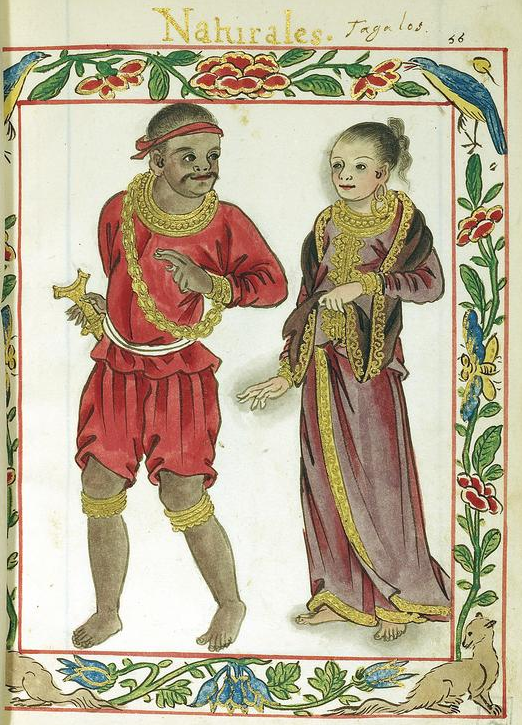
A Tagalog couple belonging to the Maharlika caste described in the Boxer codex.
Datu – The Tagalog maginoo, the Kapampangan ginu, and the Visayan tumao were the nobility social class among various cultures of the pre-colonial Philippines. Among the Visayans, the tumao were further distinguished from the immediate royal families, or a ruling class.
Timawa
Maharlika
Alipin – Commonly described as "servant" or "slave". However, this is inaccurate. The concept of the alipin relied on a complex system of obligation and repayment through labor in ancient Philippine society, rather than on the actual purchase of a person as in Western and Islamic slavery. Members of the alipin class who owned their own houses were more accurately equivalent to medieval European serfs and commoners.
By the 15th century, Arab and Indian missionaries and traders from Malaysia and Indonesia brought Islam to the Philippines, where it both replaced and was practiced together with indigenous religions.
Before that, indigenous tribes of the Philippines practiced a mixture of Animism, Hinduism and Buddhism. Native villages, called barangays were populated by locals called Timawa (Middle Class/ freemen) and Alipin (servants & slaves). They were ruled by Rajahs, Datus and Sultans, a class called Maginoo (royals) and defended by the Maharlika (Lesser nobles, royal warriors and aristocrats).[53] These Royals and Nobles are descended from native Filipinos with varying degrees of Indo-Aryan and Dravidian, which is evident in today's DNA analysis among South East Asian Royals. This tradition continued among the Spanish and Portuguese traders who also intermarried with the local populations.[69]
Hispanic settlement and rule (1521–1898)
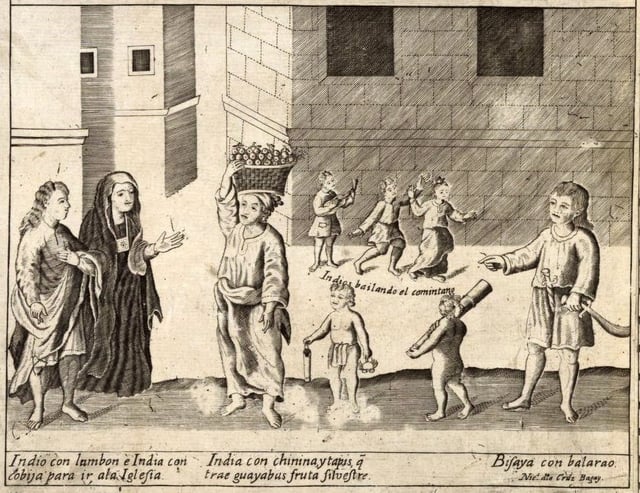
Native Filipinos as illustrated in the Carta Hydrographica y Chorographica de las Yslas Filipinas
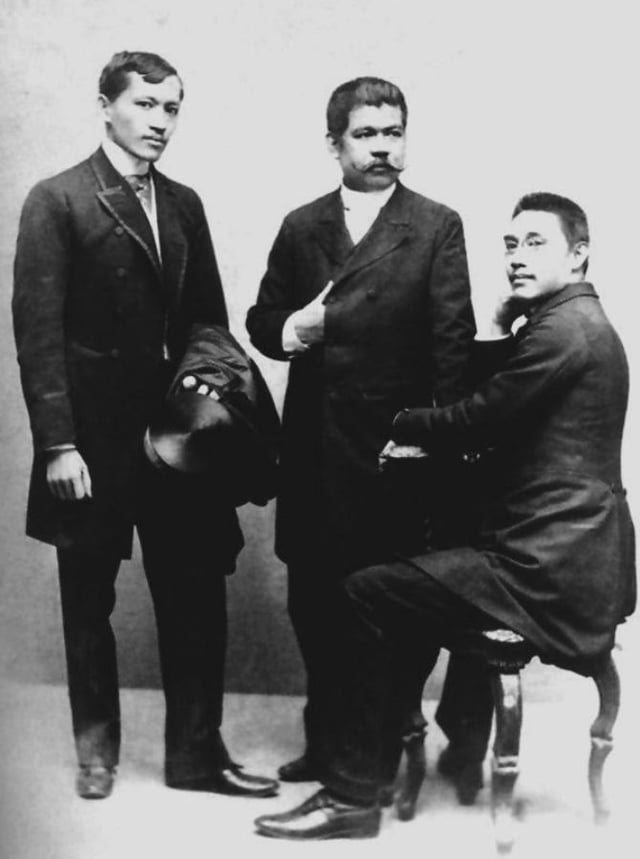
Leaders of the reform movement in Spain: left to right: José Rizal, Marcelo H. del Pilar, and Mariano Ponce (c. 1890)
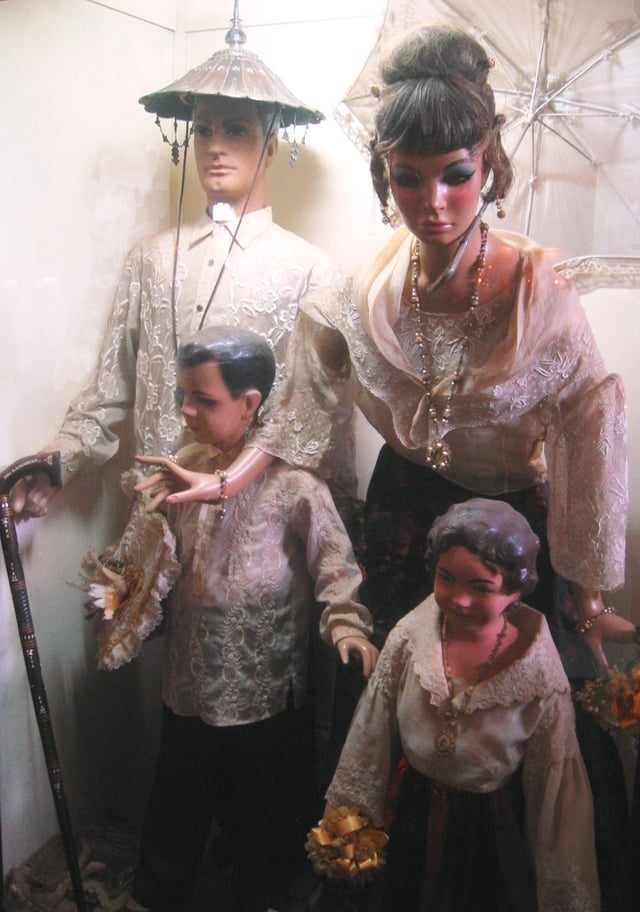
Typical costume of a Principalía family of the late 19th century. Exhibit in the Villa Escudero Museum, San Pablo, Laguna, Philippines.
The Philippines was settled by the Spanish.
The arrival of Portuguese explorer Ferdinand Magellan (Portuguese: Fernão de Magalhães) in 1521 began a period of European colonization. During the period of Spanish colonialism the Philippines was part of the Viceroyalty of New Spain, which was governed and controlled from Mexico City. Early Spanish settlers were mostly explorers, soldiers, government officials and religious missionaries born in Spain and Mexico. Most Spaniards who settled were of Andalusian ancestry but there were also Catalan, Moorish and Basque settlers. The Peninsulares (governors born in Spain), mostly of Castilian ancestry, settled in the islands to govern their territory. Most settlers married the daughters of rajahs, datus and sultans to reinforce the colonization of the islands. The Ginoo and Maharlika castes (royals and nobles) in the Philippines prior to the arrival of the Spanish formed the privileged Principalía (nobility) during the Spanish period. In the 16th and 17th centuries, thousands of Japanese traders also migrated to the Philippines and assimilated into the local population.[70]
As a part of the Seven Years' War, British forces occupied Manila between 1762 and 1764. However, the only part of the Philippines which the British held was the Spanish colonial capital of Manila and the principal naval port of Cavite, both of which are located on Manila Bay. The war was ended by the Treaty of Paris (1763). At the end of the war the treaty signatories were not aware that Manila had been taken by the British and was being administered as a British colony. Consequently, no specific provision was made for the Philippines. Instead they fell under the general provision that all other lands not otherwise provided for be returned to the Spanish Empire.[71] Many Indian Sepoy troops and their British captains mutinied and were left in Manila and some parts of the Ilocos and Cagayan. The ones in Manila settled at Cainta, Rizal and the ones in the north settled in Isabela. Most were assimilated into the local population.
The arrival of the Spaniards to the Philippines attracted new waves of immigrants from China, and maritime trade flourished during the Spanish period. The Spanish recruited thousands of Chinese migrant workers called sangleys to build the colonial infrastructure in the islands. Many Chinese immigrants converted to Christianity, intermarried with the locals, and adopted Hispanized names and customs and became assimilated, although the children of unions between Filipinos and Chinese that became assimilated continued to be designated in official records as mestizos de sangley
A total of 110 Manila-Acapulco galleons set sail between 1565 and 1815, during the Philippines trade with Mexico. Until 1593, three or more ships would set sail annually from each port bringing with them the riches of the archipelago to Spain. European criollos, mestizos and Portuguese, French and Mexican descent from the Americas, mostly from Latin America came in contact with the Filipinos. Japanese, Indian and Cambodian Christians who fled from religious persecutions and killing fields also settled in the Philippines during the 17th until the 19th centuries.
With the inauguration of the Suez Canal in 1867, Spain opened the Philippines for international trade. European investors such as British, Dutch, German, Portuguese, Russian, Italian and French were among those who settled in the islands as business increased. More Spaniards arrived during the next century. Many of these European migrants intermarried with local mestizos and assimilated with the indigenous population.
Late modern
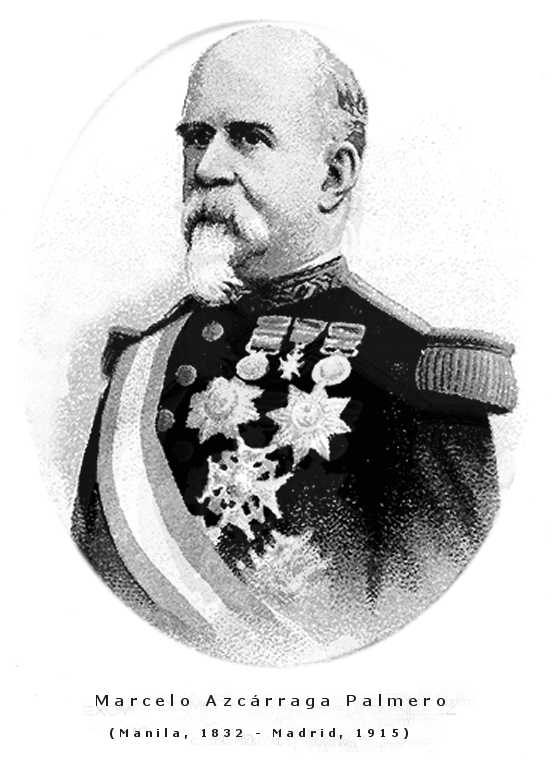
Marcelo Azcárraga Palmero, the only Spanish prime minister of Insulares (Filipino) descent
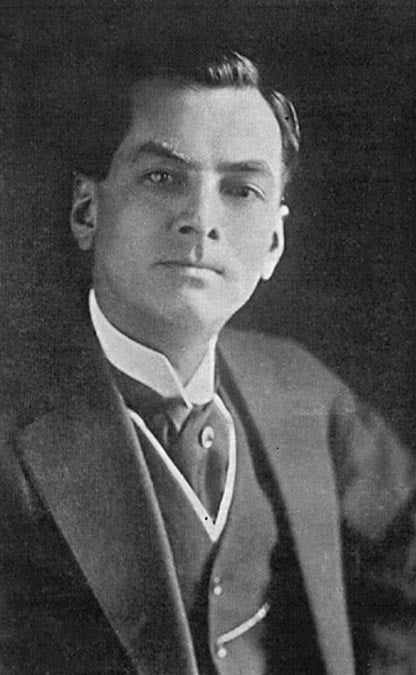
Manuel L. Quezon was the Philippine President during the Commonwealth era.
A mestiza de sangley
After the defeat of Spain during the Spanish–American War in 1898, Filipino general, Emilio Aguinaldo declared independence on 12 June while General Wesley Merritt became the first American governor of the Philippines. On 10 December 1898, the Treaty of Paris formally ended the war, with Spain ceding the Philippines and other colonies to the United States in exchange for $20 million.[72][73] The Philippine–American War resulted in the deaths of at least 200,000 Filipino civilians.[74] Some estimates for total civilian dead reach up to 1,000,000.[75][76] After the Philippine–American War, the United States civil governance was established in 1901, with William Howard Taft as the first American Governor-General.[77] A number of Americans settled in the islands and thousands of interracial marriages between Americans and Filipinos have taken place since then. Due to the strategic location of the Philippines, as many as 21 bases and 100,000 military personnel were stationed there since the United States first colonized the islands in 1898. These bases were decommissioned in 1992 after the end of the Cold War, but left behind thousands of Amerasian children.[78] The country gained independence from the United States in 1946. The Pearl S. Buck International Foundation estimates there are 52,000 Amerasians scattered throughout the Philippines. However, according to the center of Amerasian Research, there might be as many as 250,000 Amerasians scattered across the cities of Angeles, Manila, Clark, and Olongapo.[79] In addition, numerous Filipino men enlisted in the US Navy and made careers in it, often settling with their families in the United States. Some of their second- or third-generation families returned to the country.
Following its independence, the Philippines has seen both small and large-scale immigration into the country, mostly involving American, European, Chinese, and Japanese peoples.
After World War II, South Asians continued to migrate into the islands, most of which assimilated and avoided the local social stigma instilled by the early Spaniards against them by keeping a low profile and/or by trying to pass as Spanish mestizos. This was also true for the Arab and Chinese immigrants, many of whom are also post WWII arrivals. More recent migrations into the country by Koreans, Persians, Brazilians, and other Southeast Asians have contributed to the enrichment of the country's ethnic landscape, language and culture. Centuries of migration, diaspora, assimilation, and cultural diversity made most Filipinos accepting of interracial marriage and multiculturalism.
Philippine nationality law is currently based upon the principle of jus sanguinis and, therefore, descent from a parent who is a citizen of the Republic of the Philippines is the primary method of acquiring national citizenship. Birth in the Philippines to foreign parents does not in itself confer Philippine citizenship, although RA9139, the Administrative Naturalization Law of 2000, does provide a path for administrative naturalization of certain aliens born in the Philippines. Filipinos of mixed ethnic origins are still referred to today as mestizos
| Term | Definition |
|---|---|
| Negrito | indigenous person of purelyNegritoancestry |
| Indio | indigenous person of purelyAustronesianancestry |
| Moros | indigenous person of the Islamic faith living in the Archipelago of the Philippines |
| Sangley/Chino | person of purely Chinese ancestry |
| Mestizo de Sangley/Chino | person of mixed Chinese and Austronesian ancestry |
| Mestizo de Español | person of mixed Spanish and Austronesian ancestry |
| Tornatrás | person of mixed Spanish, Austronesian and Chinese ancestry |
| Insulares/Filipino | person of purely Spanish descent born in the Philippines |
| Americanos | person ofCriollo(either pure Spanish blood, or mostly),Castizo(1/4 Native American, 3/4 Spanish) or Mestizo(1/2 Spanish, 1/2 Native American) descent born in Spanish America ("from the Americas") |
| Peninsulares | person of purely Spanish descent born in Spain ("from the Iberian peninsula") |
People classified as 'blancos' (whites) were the insulares or "Filipinos" (a person born in the Philippines of pure Spanish descent), peninsulares (a person born in Spain of pure Spanish descent), Español mestizos (a person born in the Philippines of mixed Austronesian and Spanish ancestry), and tornatrás (a person born in the Philippines of mixed Austronesian, Chinese and Spanish ancestry).
Manila was racially segregated, with blancos living in the walled city of Intramuros, un-Christianized sangleys in Parían, Christianized sangleys and mestizos de sangley in Binondo, and the rest of the 7,000 islands for the indios, with the exception of Cebu and several other Spanish posts. Only mestizos de sangley were allowed to enter Intramuros to work for whites (including mestizos de español) as servants and various occupations needed for the colony. Indio were native Austronesians, but as a legal classification, Indio were those who embraced Roman Catholicism and Austronesians who lived in proximity to the Spanish colonies.
People who lived outside Manila, Cebu and the major Spanish posts were classified as such: 'Naturales' were Catholic Austronesians of the lowland and coastal towns. The un-Catholic Negritos and Austronesians who lived in the towns were classified as 'salvajes' (savages) or 'infieles' (the unfaithful). 'Remontados' (Spanish for 'situated in the mountains') and 'tulisanes' (bandits) were indigenous Austronesians and Negritos who refused to live in towns and took to the hills, all of whom were considered to live outside the social order as Catholicism was a driving force in Spanish colonials everyday life, as well as determining social class in the colony. People of pure Spanish descent living in the Philippines who were born in Spanish America were classified as 'americanos'. Mestizos and africanos born in Spanish America living in the Philippines kept their legal classification as such, and usually came as indentured servants to the 'americanos'. The Philippine-born children of 'americanos' were classified as 'Ins'. The Philippine-born children of mestizos and Africanos from Spanish America were classified based on patrilineal descent.
The term negrito was coined by the Spaniards based on their appearance. The word 'negrito' would be misinterpreted and used by future European scholars as an ethnoracial term in and of itself. Both Christianized negritos who lived in the colony and un-Christianized negritos who lived in tribes outside the colony were classified as 'negritos'. Christianized negritos who lived in Manila were not allowed to enter Intramuros and lived in areas designated for indios.
A person of mixed Negrito and Austronesian ancestry were classified based on patrilineal descent; the father's ancestry determined a child's legal classification. If the father was 'negrito' and the mother was 'India' (Austronesian), the child was classified as 'negrito'. If the father was 'indio' and the mother was 'negrita', the child was classified as 'indio'. Persons of Negrito descent were viewed as being outside the social order as they usually lived in tribes outside the colony and resisted conversion to Christianity.
This legal system of racial classification based on patrilineal descent had no parallel anywhere in the Spanish-ruled colonies in the Americas.
In general, a son born of a sangley male and an indio or mestizo de sangley female was classified as mestizo de sangley; all subsequent male descendants were mestizos de sangley regardless of whether they married an India or a mestiza de sangley.
A daughter born in such a manner, however, acquired the legal classification of her husband, i.e., she became an India if she married an indio but remained a mestiza de sangley if she married a mestizo de sangley or a sangley.
In this way, a chino mestizo male descendant of a paternal sangley ancestor never lost his legal status as a mestizo de sangley no matter how little percentage of Chinese blood he had in his veins or how many generations had passed since his first Chinese ancestor; he was thus a mestizo de sangley in perpetuity.
However, a 'mestiza de sangley' who married a blanco ('Filipino', 'mestizo de español', 'peninsular', or 'americano') kept her status as 'mestiza de sangley'.
But her children were classified as tornatrás.
An 'India' who married a blanco also kept her status as India, but her children were classified as mestizo de español.
A mestiza de español who married another blanco would keep her status as mestiza, but her status will never change from mestiza de español if she married a mestizo de español, Filipino, or peninsular.
On the contrast, a mestizo (de sangley or español) man's status stayed the same regardless of whom he married.
If a mestizo (de sangley or español) married a filipina (woman of pure Spanish descent), she would lose her status as a 'filipina' and would acquire the legal status of her husband and become a mestiza de español or sangley.
If a 'filipina' married an 'indio', her legal status would change to 'India', despite being of pure Spanish descent.
The social stratification system based on class that continues to this day in the Philippines has its beginnings in the Spanish colonial area with this caste system.
The Spanish colonizers reserved the term Filipino to refer to Spaniards born in the Philippines. The use of the term was later extended to include Spanish and Chinese mestizos, or those born of mixed Chinese-indio or Spanish-indio descent. Late in the 19th century, José Rizal popularized the use of the term Filipino to refer to all those born in the Philippines, including the Indios.[80] When ordered to sign the notification of his death sentence, which described him as a Chinese mestizo, Rizal refused. He went to his death saying that he was indio puro.[81][80]
The Spanish caste system based on race was abolished after the Philippines' independence from Spain in 1898, and the word 'Filipino' expanded to include the entire population of the Philippines regardless of racial ancestry.
Origins and genetic studies
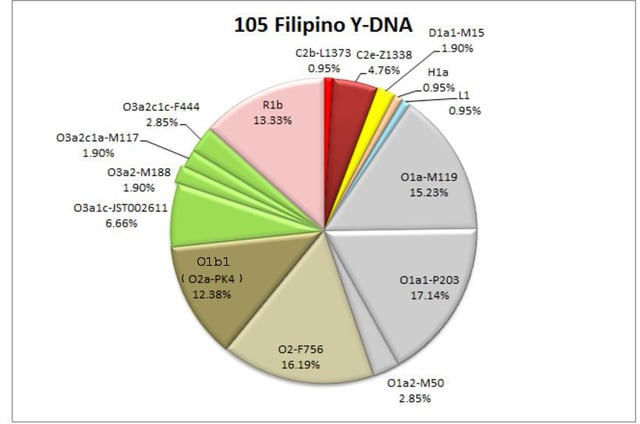
According to the Y-DNA study of Filipino males from the gene bank of the company, Applied Biosystems, most Philippine Y-DNA haplogroups were found to be O1 (O1a) and O2 (O1b1), both of which are common in populations from Southeast Asia as far north as the Yangtze Delta.[87] However, around 13% of the population is confirmed to have the Y-DNA haplogroup R1b, which has spread to the Philippines from Spain and Latin America, and another 13% belong to haplogroup O3 (O2-M122), which is especially common in populations of China. The same Y-DNA study showed an estimated 1% frequency of the South Asian (Indian) haplogroup H1a. Making about an amount of 1 percent of Filipino men having Indian ancestry. Furthermore, a similar 1% frequency of the Haplogroup I1 which is of Nordic European origin makes another 1 percent of Filipino men, of Nordic ancestry. The above circular statistical graphic incorrectly reads "L1" (in one of its Haplogroup indentifications), when it should be "I1" [88].
The aboriginal settlers of the Philippines were primarily Negrito groups, an Australoid group and a left-over from the first human migration out of Africa to Australia. Negritos comprise a small minority of the nation’s overall population. They, along with Papuans, Melanesians and Australian Aboriginals also hold sizable Denisovan admixture in their genomes.[83] The majority population of Filipinos, however, are Austronesians, a linguistic and genetic group whose historical ties lay in maritime Southeast Asia, but through ancient migrations can be found as indigenous peoples stretching as far east as the Pacific islands and as far west as Madagascar off the coast of Africa.[84][85] The current predominant theory on Austronesian expansion holds that Austronesians settled the Philippine islands through successive southward and eastward seaborne migrations from the Neolithic Austronesian populations of Taiwan.[86]
Other hypotheses have also been put forward based on linguistic, archeological, and genetic studies.
These include an origin from mainland South China (linking them to the Liangzhu culture and the Tapengkeng culture, later displaced or assimilated by the expansion of Sino-Tibetan peoples);[89][90] an in situ origin from the Sundaland continental shelf prior to the sea level rise at the end of the last glacial period (c. 10,000 BC);[91][92] or a combination of the two (the Nusantao Maritime Trading and Communication Network hypothesis) which advocates cultural diffusion rather than a series of linear migrations.[93]
The most frequently occurring Y-DNA haplogroups among modern Filipinos are haplogroup O1a-M119, which has been found with maximal frequency among the indigenous peoples of Nias, the Mentawai Islands, and Taiwan, and Haplogroup O2-M122, which is found with high frequency in many populations of East Asia, Southeast Asia, and Polynesia. In particular, the type of O2-M122 that is found frequently in Filipinos, O-P164(xM134), is also found frequently in other Austronesian populations.[94][95] Trejaut et al. 2014 found O2a2b-P164(xO2a2b1-M134) in 26/146 = 17.8% of a pool of samples of Filipinos (4/8 = 50% Mindanao, 7/31 = 22.6% Visayas, 10/55 = 18.2% South Luzon, 1/6 = 17% North Luzon, 2/22 = 9.1% unknown Philippines, 2/24 = 8.3% Ivatan). The distributions of other subclades of O2-M122 in the Philippines were sporadic, but it may be noted that O2a1c-JST002611 was observed in 6/24 = 25% of a sample of Ivatan and 1/31 = 3.2% of a sample from the Visayas. A total of 45/146 = 30.8% of the sampled Filipinos were found to belong to Haplogroup O2-M122.[94] Haplogroup O1a-M119 is also commonly found among Filipinos (25/146 = 17.1% O1a-M119(xO1a1a-P203, O1a2-M50), 20/146 = 13.7% O1a1a-P203, 17/146 = 11.6% O1a2-M50, 62/146 = 42.5% O1a-M119 total according to Trejaut et al. 2014) and is shared with other Austronesian-speaking populations, especially those in Taiwan, western Indonesia, and Madagascar.[85][96]
After the 16th century, the colonial period saw the influx of genetic influence from other populations.
This is evidenced by the presence of a small percentage of the Y-DNA Haplogroup R1b present among the population of the Philippines. DNA studies vary as to how small these lineages are. A year 2001 study conducted by Stanford University Asia-Pacific Research Center stated that only 3.6% of the Philippine population had European Y-DNA. However, only 28 individuals from the isolated rural island of Palawan were genotyped for this study, a sample size far below the minimum sample size needed to account for credible test results in a population of over 100 million individuals.[97] According to another genetic study done by the University of California (San Francisco), they discovered that a more "modest" amount of European genetic ancestry was found among some respondents who self-identified as Filipinos.[98] A 2015, Y-DNA compilation by the Genetic Company: "Applied Biosystems", using samples taken from all over the Philippines, resulted in a still modest 13.33% frequency of the European/Spanish Y-DNA R1b which reached the Philippines via military settlement from Peru or Mexico where these soldiers had Spanish Fathers and Amerindian Mothers.[99] The same Y-DNA study showed an estimated 1% frequency of the South Asian (Indian) haplogroup H1a, and less than 1% frequency of the Haplogroup I1 which is of Nordic European origin and disseminated, in part, with Viking migrations.
The largest and most recent genetic study thus far, conducted by the National Geographic's "The Genographic Project", based on a massive genetic testing of 80,000 Filipinos by the National Geographic in 2008–2009 found that the Philippines’ autosomal genepool is overwhelmingly Asian, consisting of 53% Southeast Asian and Oceanian genes, and 36% East Asian genes, with only 5% Southern European genes, 3% South Asian (Indian subcontinent) genes, and 2% Native American genes.[100] Note that these percentages do not represent the average admixture of every Filipino, but rather represents the genepool of all Filipinos combined, with each individual Filipino varying or even lacking any degree of admixture from one or more said ancestries.
That the genome of the Philippines is estimated to be 5% Southern European (largely Iberian; i.e. Spanish and/or Portuguese) but an almost similar amount of 2% is also Native American attests to the fact that most of the few Hispanic settlers of the Philippines were actually Latin American mestizos (people of mixed Spanish and Native American ancestry) rather than Spaniards from Spain, as the Philippines was administered by the Viceroyalty of New Spain (today’s Mexico) instead of Spain. The Stanford study says that 3.6% (that is 1 out of 28) have shown to have European paternal markers. That is, the Y chromosome passed by the males to their male offspring/descendants (aka unbroken male lineage). The European ancestry was actually more of a side note as the study was geared towards "interbreeding" between Homo erectus and homo sapiens.[85] Furthermore, the Stanford study was conducted on an isolated portion of the Philippines barely touched by Spanish colonization, had the study been conducted in the more densely populated areas of the north, there would have been more European ancestry detected due to the location being the center of Hispanic settlements (Latin Americans and Spaniards) during the colonial period. In relation to that, a population survey conducted by German ethnograper Fedor Jagor concluded that 1/3rd of Luzon which holds half of the Philippines' population had varying degrees of Spanish and Latin American ancestry.[101]
Dental morphology provides clues to prehistoric migration patterns of the Philippines, with Sinodont dental patterns occurring in East Asia, Central Asia, North Asia, and the Americas. Sundadont patterns occur in mainland and maritime Southeast Asia as well as Oceania.[102] Filipinos exhibit Sundadonty,[102][103] and are regarded as having a more generalised dental morphology and having a longer ancestry than its offspring, Sinodonty.
Languages
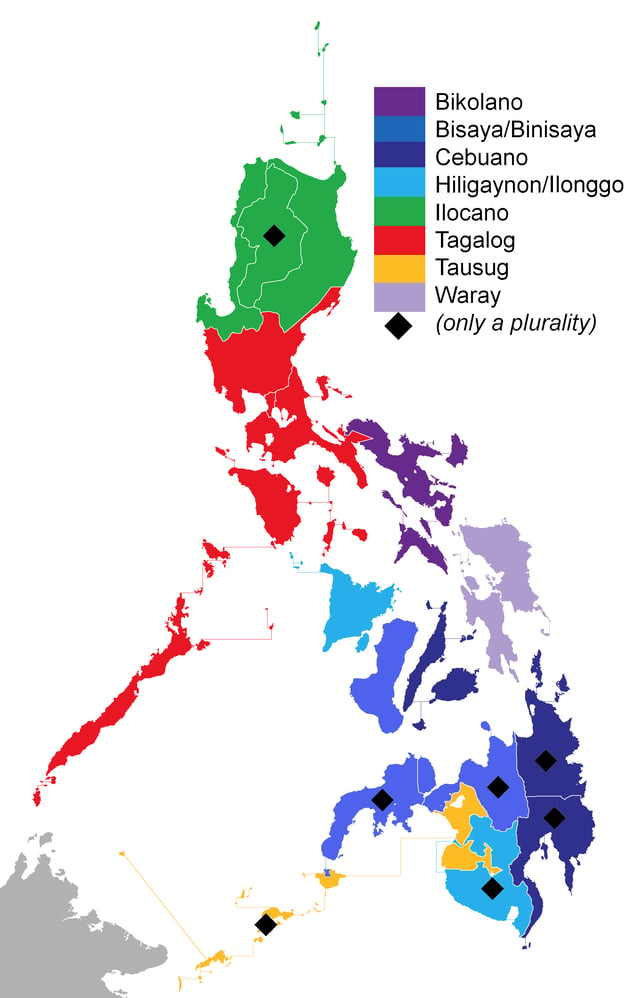
The indigenous (native) Philippine languages spoken around the country that have the largest number of speakers in a particular region with Tagalog being the largest.
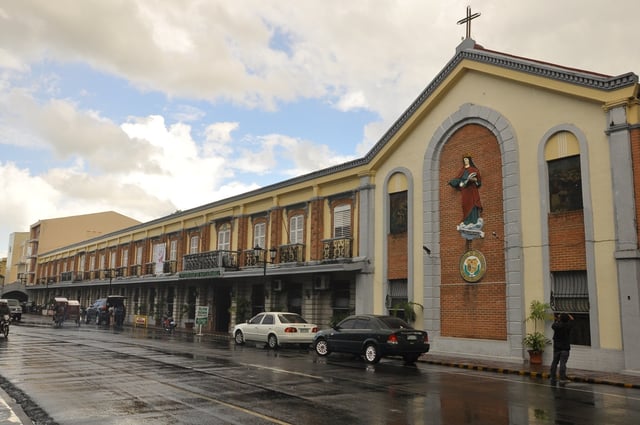
Universidad de Sta. Isabel, founded in 1867 through the royal order of Queen Isabella II of Spain
Austronesian languages have been spoken in the Philippines for thousands of years. According to a 2014 study by Mark Donohue of the Australian National University and Tim Denham of Monash University, there is no linguistic evidence for an orderly north-to-south dispersal of the Austronesian languages from Taiwan through the Philippines and into Island Southeast Asia (ISEA).[91] Many adopted words from Sanskrit and Tamil were incorporated during the strong wave of Indian (Hindu-Buddhist) cultural influence starting from the 5th century BC, in common with its Southeast Asian neighbors. Chinese languages were also commonly spoken among the traders of the archipelago. However with the advent of Islam, Arabic and Persian soon came to supplant Sanskrit and Tamil as holy languages. Starting in the second half of the 16th century, Spanish was the official language of the country for the more than three centuries that the islands were governed through Mexico City on behalf of the Spanish Empire. The variant of Spanish used was Mexican-Spanish, which also included much vocabulary of Nahuatl (Aztec) origin. In the 19th and early 20th centuries, Spanish was the preferred language among Ilustrados and educated Filipinos in general. Significant agreements exist, however, on the extent Spanish use beyond that. It has been argued that the Philippines were less hispanized than Canaries and America, with Spanish only being adopted by the ruling class involved in civil and judicial administration and culture. Spanish was the language of only approximately ten percent of the Philippine population when Spanish rule ended in 1898.[104] As a lingua franca or creole language of Filipinos, major languages of the country like Chavacano, Cebuano, Tagalog, Kapampangan, Pangasinan, Bicolano, Hiligaynon, and Ilocano assimilated many different words and expressions from Castilian Spanish.
Chavacano is the only Spanish-based creole language in Asia. Its vocabulary is 90 percent Spanish, and the remaining 10 percent is a mixture of predominantly Portuguese, Nahuatl (Mexican Indian), Hiligaynon, and some English. Chavacano is considered by the Instituto Cervantes to be a Spanish-based language.[105]
In sharp contrast, another view is that the ratio of the population which spoke Spanish as their mother tongue in the last decade of Spanish rule was 10% or 14%.[106] An additional 60% is said to have spoken Spanish as a second language until World War II, but this is also disputed as to whether this percentage spoke "kitchen Spanish", which was used as marketplace lingua compared to those who were actual fluent Spanish speakers.[106]
In 1863 a Spanish decree introduced universal education, creating free public schooling in Spanish, yet it was never implemented, even before the advent of American annexation.[107] It was also the language of the Philippine Revolution, and the 1899 Malolos Constitution proclaimed it as the "official language" of the First Philippine Republic, albeit a temporary official language. Spanish continued to be the predominant lingua franca used in the islands by the elite class before and during the American colonial regime. Following the American occupation of the Philippines and the imposition of English, the overall use of Spanish declined gradually, especially after the 1940s.
According to Ethnologue, there are about 180 languages spoken in the Philippines.[108] The 1987 Constitution of the Philippines imposed the Filipino language.[109][110] as the national language and designates it, along with English, as one of the official languages. Regional languages are designated as auxiliary official languages. The constitution also provides that Spanish and Arabic shall be promoted on a voluntary and optional basis.[111]
Other Philippine languages in the country with at least 1,000,000 native and indigenous speakers include Cebuano, Ilocano, Hiligaynon, Waray, Central Bikol, Kapampangan, Pangasinan, Chavacano (Spanish-based creole), Albay Bikol, Maranao, Maguindanao, Kinaray-a, Tausug, Surigaonon, Masbateño, Aklanon and Ibanag. The 28-letter modern Filipino alphabet, adopted in 1987, is the official writing system. Also, language of each ethnicity has also their own writing scripts, which are no longer used and set of alphabets.[112]
Religion
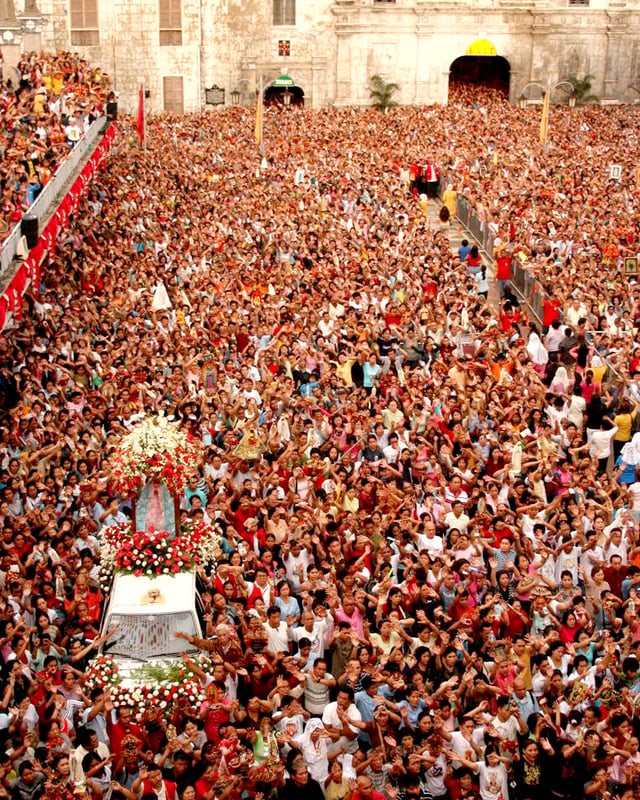
Devotees flock to the Basilica Minore del Santo Niño during the novena Masses.
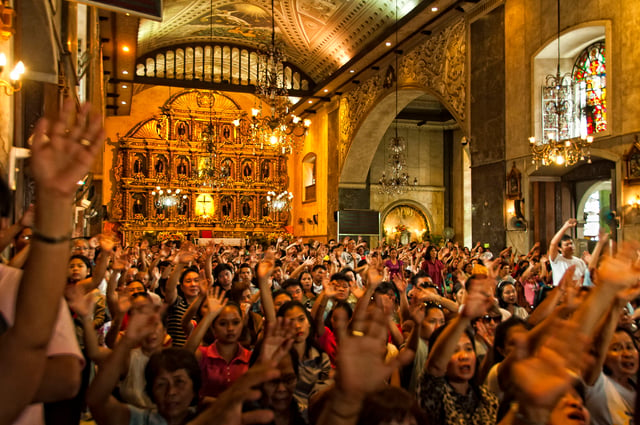
Devotees inside the Bascilica del Santo Niño in Cebu City
As of 2010, over 90% of the population were Christians, with over 80% professing Roman Catholicism.[39] The latter was introduced by the Spanish beginning in 1565, and during their 300-year colonization of the islands, they managed to convert a vast majority of Filipinos, resulting in the Philippines becoming the largest Catholic country in Asia. There are also large groups of Protestant denominations, which either grew or were founded following the disestablishment of the Catholic Church during the American Colonial period. The Iglesia ni Cristo is currently the single largest indigenous church, followed by United Church of Christ in the Philippines. The Iglesia Filipina Independiente (also known as the Aglipayan Church) was an earlier development, and is a national church directly resulting from the 1898 Philippine Revolution. Other Christian groups such as the Victory Church,[114] Jesus Miracle Crusade, Mormonism, Orthodoxy, and the Jehovah's Witnesses have a visible presence in the country. Other native inhabitants follow Islam.[115], forming a large minority. Islam in the Philippines is mostly concentrated in southwestern Mindanao and the Sulu Archipelago which, though part of the Philippines, are very close to the neighboring Islamic countries of Malaysia and Indonesia. The Muslims call themselves Moros, a Spanish word that refers to the Moors (albeit the two groups have little cultural connection other than Islam).
Historically, ancient Filipinos held animistic beliefs that were influenced by Hinduism and Buddhism, which were brought by traders from neighbouring Asian states. Indigenous groups like the Aeta are Animists, while Igorot and Lumad tribes still observe traditional religious practises, often alongside Christianity or Islam.
As of 2013, religious groups together constituting less than five percent of the population included Sikhism, Hinduism, Buddhism, Seventh-day Adventists, United Church of Christ, United Methodists, the Episcopal Church in the Philippines, Assemblies of God, The Church of Jesus Christ of Latter-day Saints (Mormons), and Philippine (Southern) Baptists; and the following domestically established churches: Iglesia ni Cristo (Church of Christ), Philippine Independent Church (Aglipayan), Members Church of God International, and The Kingdom of Jesus Christ, the Name Above Every Name. In addition, there are Lumad, who are indigenous peoples of various animistic and syncretic religions.[115]
Diaspora
There are an estimated four million Americans of Filipino ancestry in the United States, and more than 300,000 American citizens in the Philippines.[119] According to the U.S. Census Bureau, immigrants from the Philippines made up the second largest group after Mexico that sought family reunification.[120]
See also
Pinoy
Philippines
Demographics of the Philippines
Ethnic groups in the Philippines
Philippine nationality law
List of rulers of the Philippines
List of Filipino athletes
List of Filipino actors
List of Filipino actresses
List of Filipino comedians
List of Filipino writers
Overseas Filipinos
Filipino cuisine
Filipinos in Hawaii
Filipinos in the New York metropolitan area
Philippine music
Philippine cinema

